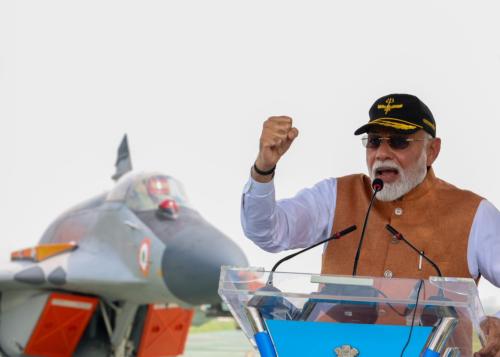Editor’s Note: The Islamic State’s downing of the Russian airplane over the Sinai Peninsula and killing spree in Paris suggest that the group has changed its tactics and is now going global. Jennifer Williams explains why terrorism experts may have missed this change. This post originally appeared on Lawfare.
Many terrorism analysts, myself included, have argued that the Islamic State poses only a limited terrorism threat to the United States homeland, and to the West in general, because the group has primarily focused on its caliphate-building project in Iraq and Syria and, unlike its rival al Qaeda, has little interest in attacking the West. Even though ISIS propagandists frequently called on “every Muslim in every place” to “fight in his land wherever that may be,” this call to arms was almost always offered as a secondary option. The first and best option was to travel to the lands of the Islamic State to fight there. Since the Islamic State had been around in various incarnations for over a decade and had not prioritized attacking the West, the track record seemed clear.
Some analysts also argued, and many more of us agreed, that the potential terrorism threat from the thousands of foreign fighters emigrating from Western countries — including hundreds from France — who have traveled to Iraq and Syria to join the Islamic State was not as serious as some suggested. This was in part because it seemed the Islamic State was more interested in using these Western foreign fighters as suicide bombers in Iraq and Syria than in taking the time to train them and send them back to the West. There is an opportunity cost with every martyr, after all.
Sure, we acknowledged, terrorist attacks in the United States and Europe were almost certainly going to occur, but they would most likely be small-scale, amateurish, low-casualty attacks of the kind carried out by untrained — and often unhinged — lone wolves. Big, complex, high-level terrorism spectaculars like 9/11 or the London subway bombings were likely beyond their reach.
Then the Paris attacks happened.
Although the details are still unfolding, it seems the perpetrators of the Paris attacks were affiliated with the Islamic State, and this operation may actually have been directed from the Islamic State’s top ranks. It is also possible that some or all of them received training in Iraq or Syria (though that has not been established definitively as of now). The degree to which the central leadership of the Islamic State was involved in the operation remains unclear, but if it turns out that they were involved beyond just inspiring the attackers, then I and many of my fellow terrorism analysts got it wrong when we downplayed the terrorism threat to the West emanating from Iraq and Syria.
In this business, baring a few notable exceptions, it is rare to acknowledge publicly that your assessments or predictions turned out to be wrong. After all, pointing out that you completely misread the issue on which you claim to be an expert is not, generally speaking, the smartest career move. Better to just write a new op-ed claiming that your expert assessment of the situation today is absolutely correct, without bothering to mention that yesterday’s op-ed was 100% wrong. Pay no attention to the man behind the curtain.
The degree to which the central leadership of the Islamic State was involved in the operation remains unclear, but if it turns out that they were involved beyond just inspiring the attackers, then I and many of my fellow terrorism analysts got it wrong when we downplayed the terrorism threat to the West emanating from Iraq and Syria.
But to me, that acknowledgement is the difference between being a pundit and being an analyst. The pundit obfuscates her error to maintain her professional credibility in the eyes of those who either don’t know or don’t care enough to look closely; the analyst owns and examines her error in order to identify where she went wrong and adjust her understanding of the issue accordingly.
In the immediate aftermath of the Paris attacks, many analysts have described the decision by the Islamic State to launch an attack, not just well outside its regional theater of operations but in the very heart of a major Western country, as a major shift in strategy on the part of the Islamic State. It’s entirely possible that is true and the Paris attacks represent a significant and deliberate strategic shift on the part of the group’s central leadership, perhaps in response to losses on the ground in Iraq and Syria and perceptions that it was no longer being seen as a “winner.” That has always been a critical factor in the group’s ability to recruit thousands of fighters to its ranks.
But we must also examine another possibility: that this has been their strategy all along, and we just missed it — after all, they have been calling for attacks in the West, and France in particular, for some time now. If that is the case, it is important that we, as analysts, perform an honest assessment of where we went wrong. Did we overestimate the strategic differences between al Qaeda and the Islamic State? Did we let our own weariness of U.S. military intervention in the Middle East cloud our judgment, making us unintentionally overlook clear signs that this organization was more than just a regional threat? Did we fail to examine critically both our assumptions and the available evidence in favor of accepting the prevailing narrative put forward by our peers? Or were we right yesterday, but the organization changed today — and may change again tomorrow — and we simply failed to anticipate its new direction?
But we must also examine another possibility: that this has been their strategy all along, and we just missed it…
I don’t know the answers to these questions. I don’t even know if I was actually wrong. Maybe the Paris attacks were not directed by the central leadership of the Islamic State at all and were merely planned and executed by individuals inspired by the group’s ideology. My gut instinct is that the truth is probably somewhere in the middle: that the individuals had some ties to the Islamic State, and perhaps even ties to the broader jihadi network that could include individuals more closely aligned with al Qaeda; that some of the attackers may have received training in Islamic State camps — or even fought in actual battles — in Iraq and Syria; but that the central leadership was not directly involved in the Paris attacks in the way that Osama bin Laden and other top leaders in al Qaeda were involved in the 9/11 attacks. In other words, that Baghdadi and his cronies didn’t provide direct financing, didn’t select or approve the specific targets, and didn’t assign specific individuals to specific roles in the operation based on their various skills and qualifications. But that’s pure speculation, and it’s entirely possible Baghdadi and his associates did plan the whole thing. Even if that’s the case, it is still possible it was a deliberate decision on his part to dramatically alter his organization’s strategy for one reason or another.
It is much harder to get definitive answers to questions about decisions made by the leadership of a clandestine organization than it is to determine the degree of operational involvement the leadership had in a single attack. You’re much more likely to be able to come up with tangible evidence indicating that leaders and operatives were working together — money transfers, travel records, communications data, etc. — than you are to find tangible records of the internal strategic deliberations of a select few paranoid, secretive terrorist leaders. Indeed, Baghdadi himself could easily lie and say this was his strategy all along, even if it wasn’t, and none of us would be the wiser. Al Qaeda, after all, regularly lied about its past, giving it a coherence and glory that in reality was lacking.
Regardless of whether attacking the West has always been a part of its strategy or whether this is a new direction for the Islamic State, there is no longer any doubt that the group and its adherents have both the desire and the capability to carry out relatively sophisticated mass-casualty attacks in the West, or at least in Europe. The conventional wisdom among most terrorism analysts has been that the Islamic State poses less of a terrorism threat to the United States than to Europe, but it might be wise to reevaluate that assessment as well, especially since the Islamic State just released a new video threatening a Paris-style attack on Washington, D.C.
The Brookings Institution is committed to quality, independence, and impact.
We are supported by a diverse array of funders. In line with our values and policies, each Brookings publication represents the sole views of its author(s).




Commentary
We were wrong about ISIS
December 2, 2015